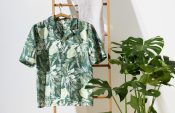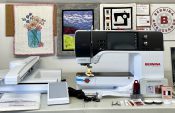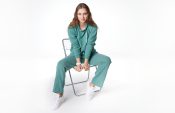This is a multi-post series, if you missed the first 2 parts you can find them here: Sewing Tools Part 1: Measuring and here: Sewing Tools Part 2: Pressing
At any point in your sewing journey you may wish to try your hand at drafting your own patterns. Here is a summary of some of the helpful supplies and gadgets I usually have to hand when pattern drafting.
Roll of paper
Whether you regularly trace off indie/commercial sewing patterns to preserve the originals or happen to be dabbling in drafting your own sewing patterns from scratch, having a large roll of semi-transparent paper to hand is going to prove invaluable.
You could just use newspaper or smaller sheets of paper stuck together, but a roll like this is fairly inexpensive and makes a useful addition to your sewing space.
Brown kraft paper or Butcher’s Paper are options, but I prefer using a roll of white as I can see through it, which makes it easier when tracing and transferring all the important information like sewing and seam allowance lines, grainlines, notches, darts, pleats, bust points, drill holes, etc.
Try getting a nice wide one (at least 1 mtr, wider is even better) to make tracing off larger pattern pieces a breeze.
Dot and Cross Pattern Paper
Essentially the same thing as what’s described above, with the helpful addition of little markings (dots, crosses or sometimes numbers) on the paper itself to simplify drawing straight/parallel/perpendicular lines and assist with alignment in general.
Swedish Tracing Paper
This stuff is so cool, it acts like paper but sews up like fabric. It’s paper-like quality means you can write all your pattern information on the pattern pieces easily, but it is more durable than paper would be, meaning you can do a lot of the patten fitting directly with these pattern pieces, potentially eliminating the need to make a toile. When you take that into consideration then the fact that you may not need to make a toile helps to offset the somewhat high price point.
Roll of Card Stock
If you are early on in your sewing journey you can most likely do without this as the previously mentioned papers will suffice, but as soon as you are wanting to draft your own blocks or slopers or design your own patterns then this is going to be a useful investment. The cardboard is going to be more durable than paper which is important if you plan to use the pattern repeatedly as it will be more able to withstand wear and tear that comes with multiple handlings.
Pattern hooks
These useful gizmos are great for hanging up your patterns for storage; this can either be long term or mid-project if you just need to get the pieces up and out of the way to clear some space. I tend to have a few current project paper patterns alongside some blocks/slopers I have drafted hung up on a metal rod I have suspended from the ceiling. You could just hang them on hangers but the pattern hooks reduce bulk and are quick and easy to access.
Pattern Hole Punch
In order to get your patterns onto the hook you will need to punch a hole into them, but the hole needs to be big enough to accommodate the size of the pattern hooks, which is larger than a regular hole punch. The professional pattern drafting hole punches are heavy and expensive, but you should be able to pick up a cheaper, handheld, single hole punch, as I did, which will just about do the trick.
Notcher
While we are looking at hole punches, let’s not forget about the trusty notcher. This gadget allows you to clip into both your paper pattern and fabric pattern pieces to demarcate all the important points in a garment, ensuring that one pattern piece will line up perfectly with its corresponding pattern piece. By using your notches as guides, you will be able to accurately line up seam lines, trickier curved seams like armscyes, pockets, seam allowance values and more.
Tracing Wheel
A tracing wheel is helpful for transferring any pattern lines or important markings onto paper or cardboard, just watch out for those spikes!
 Pencils
Pencils
Seems like an obvious one but you are going to need a sharp pencil to draft your pattern. An H graphite pencil will do the trick, or you could use a mechanical click pencil for a consistent point that is not going to get blunt. The more accurate the better.
I also like to use a pencil that is blue at one end and red at the other, you can then use the blue for tracing and red for making corrections.
Drop me a comment in the below if you have any other favourite pattern drafting tools and supplies.
Stay tuned for future posts I have lined up which will cover more nice-to-have sewing gadgets!
Stay up to date with all my latest makes over on my website: www.leannelekai.com
Come follow me over on Instagram: @leanne_lekai
 BERNINA Corporate Blog -
BERNINA Corporate Blog -















where do you buy roll of cardstock and how much comes on roll and can it be mailed?
Thanks for your message Betty! Where to buy the cardstock will depend on which country/continent you live in. Try googling ‘pattern making cardstock roll’ or similar and you will be shown the most relevant results to your location. It is available in different lengths, such as 15, 20 or 30 meters for example and can absolutely be shipped! Hope this info helps, best wishes, Leanne
Rulers! They’re vital for patternmaking. Transparent plastic rulers with a grid are perfect for straight lines and squaring. I have both metric and imperial ones for different uses. For pants, a long metal ruler is very useful. I prefer the Fairgate curved metal rulers for drafting curved areas of a pattern, both the hip curve and the vari-curve.I also have professional pattern scissors, which are a bit of an investment. They are sharp and can cut the most intricate curves accurately. For tracing out blocks and cutting both paper and fabric, heavy cast iron weights are perfect. Various sized metal washers are a good substitute.